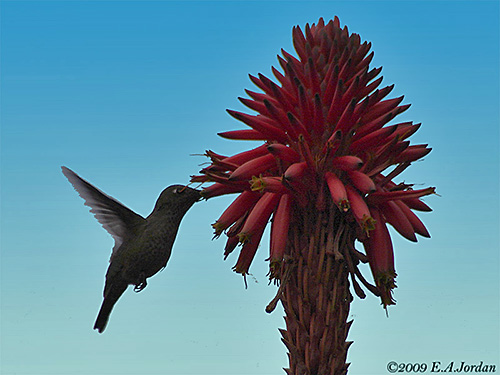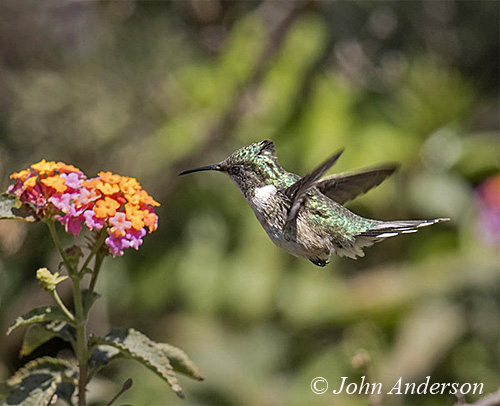
PROTECTION / THREATS / STATUS:
The Green-backed Firecrown is still relatively common within its range.
The main threat is habitat loss caused by logging and agriculture expansion. On the other hand, livestock may destroy vegetation and nest-sites.
However, the species is able to adapt to degraded habitats, and may sometimes be seen in urban parks.
The Green-backed Firecrown occurs in several protected areas and National Parks in Chile.
The size of the population is unknown, but it is suspected to be declining. But currently, the Green-backed Firecrown is not globally threatened and evaluated as Least Concern.
Fr: Colibri du Chili
Ang: Green-backed Firecrown
All: Chilekolibri
Esp: Colibrí Austral
Ita: Capo di fuoco dorsoverde
Nd: Vuurkroonkolibrie
Sd: eldkronekolibri
Photographers:
John Anderson
John Anderson Photo Galleries
Eduardo Andrés Jordan
MIS AVES – AVES DE ARGENTINA
Alan & Ann Tate
AA Bird Photography
Text by Nicole Bouglouan
Sources:
HANDBOOK OF THE BIRDS OF THE WORLD Vol 5 by Josep del Hoyo-Andrew Elliott-Jordi Sargatal - Lynx Edicions - ISBN: 8487334253
A Wildlife Guide to Chile: Continental Chile, Chilean Antarctica, Easter Island, Juan Fernandez Archipelago by Sharon Chester – Editeur: Princeton University Press, 2008 – ISBN: 0691129762, 9780691129761 – 391 pages
SORA - SAP FEEDING BY THE GREEN-BACKED FIRECROWN (SEPHANOIDES SEPHANIODES)
Pollination patterns by Green-backed Firecrown hummingbirds
Nests of the Green-backed Firecrown Sephanoides sephaniodes
Wikipedia, the free encyclopaedia

Green-backed Firecrown
Sephanoides sephaniodes
Apodiformes Order – Trochilidae Family
INTRODUCTION:
The Green-backed Firecrown is a restricted-range species found in the Andes in C Chile and adjacent W Argentina, and also on Juan Fernández Islands.
It breeds in mountain forests and woodlands, between 1,000 and 3,000 metres of elevation. It performs some altitudinal movements in winter.
The Green-backed Firecrown feeds typically on nectar from flowers and small insects.
During the breeding season, both parents feed the chicks.
The Green-backed Firecrown is affected by degradation and destruction of the habitat, but despite a slow decline of the population, the species is not globally threatened at the moment.
DESCRIPTION OF THE BIRD:
Biometrics:
Length: 9 - 11 cm
Weight: M: 5,5 g – F: 5 g
Male and female Green-backed Firecrown are very similar except on the head.
They have bronze-green upperparts, but both wings and tail are slaty-green.
The underparts are pale buff with brownish-black and green spots. These markings are larger on the body sides, and thinner on chin, throat and breast.
On the head, the male shows iridescent, bright red-orange forehead and crown, usually difficult to see.
The female has bronze-green, not iridescent crown, like the upperparts.
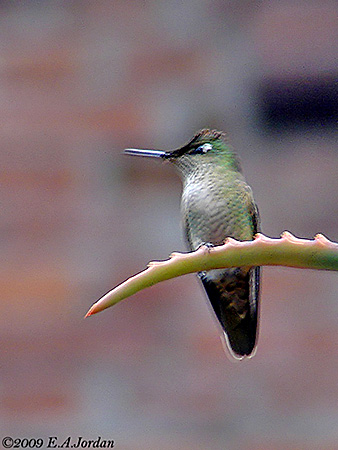
Probably a male with some
red-orange crown feathers
Both adults have a straight, black bill.
The eyes are dark brown, with a small, white spot on the rear of the eye in both sexes.
Legs and feet are black.
The juvenile has more cinnamon underparts. On the head, the feathers show rusty edges.
RANGE:
The Green-backed Firecrown is found in C Chile and adjacent Western Argentina. It is reported as fairly common in some locations such as Robinson Crusoe Island and Alejandro Selkirk Island (the latter since 1981) in the Juan Fernández Islands. On the mainland, the species can be found as far south as Tierra del Fuego.
HABITAT:
The Green-backed Firecrown breeds at high elevations (between 1,000 and 3,000 metres) in forests and woodlands in mountains where Southern Beech (Nothofagus) and Markey puzzle trees (genus Araucaria) are present.
During winter, it moves to lower elevations in valleys on the W slopes of the Andes.
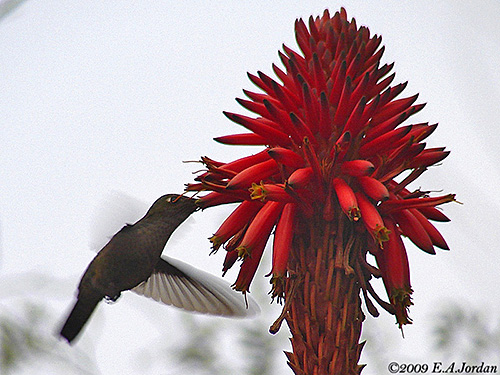
CALLS AND SONGS: SOUNDS BY XENO-CANTO
The common call of the Green-backed Firecrown is a single “psee” or “skee”.
The typical song is a series of high-pitched notes that alternate with gravelly trills and squeaky notes.
It is described as “pseee…pseee…krr.skee.skee.skee…psee…”
BEHAVIOUR IN THE WILD:
The Green-backed Firecrown feeds on nectar from flowers, especially Abutilon, Embothrium and Fuchsia.
On Juan Fernández Islands, it is observed on introduced and native species including Dendroseris and Rhaphithamnus.
It prefers flowers with tubular corollas in which it dips its long bill and extends the tongue to reach the nectar.
But the Green-backed Firecrown also takes small insects such as flies, gnats and aphids, all caught in flight. It is always very active while feeding with a fast, acrobatic flight.
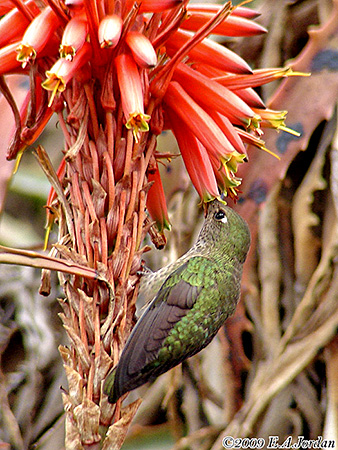
The Green-backed Firecrown was observed visiting a Coihue tree (Nothofagus dombeyi) with a crack in the bark of the trunk from which sap was flowing. The bird ignored the insects and was licking the sap, probably fermented, as it was similar to thick foam.
From other observations, several hummingbirds of this species visited these trees, and each bird tended to monopolize this resource by chasing away other individuals attempting to feed the sap. The visits were very short, from 12-13 to 24 seconds duration.
Sap is probably a minor item in the diet of the Green-backed Firecrown but this type of food contains a significant amount of energy and nutrients, constituting a very good resource for Trochilidae species.
Like most hummingbirds, it enters a state of torpor in cold weather and during the night.
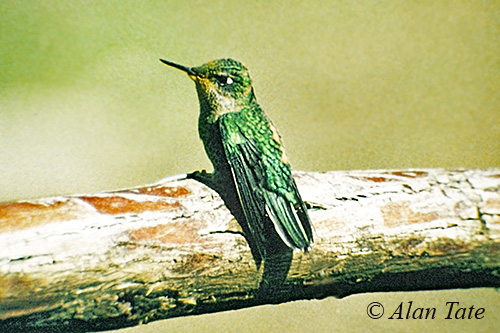
At the beginning of the breeding season, the male performs elaborate courtship displays described as U-shaped flights to impress the females.
Once the pair is formed, the female builds a small, cup-shaped nest. She incubates alone, but both parents feed the chicks.
The Green-backed Firecrown is probably sedentary on Juan Fernández Islands. The populations of the southern region of the mainland move after breeding to spend the winter in the lowlands of Argentina, and also as far E as Atlantic Coast of Chubut. They move according to the availability of food sources.
The Green-backed Firecrown forages and feeds with swift, acrobatic flight. It quickly changes of direction while buzzing from flower to flower. The nectar gives it energy for hovering when feeding, and for sustained fast flight.
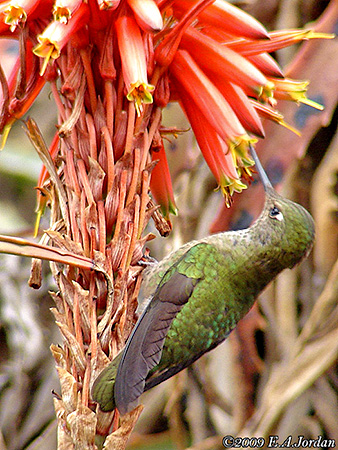
REPRODUCTION OF THIS SPECIES:
The breeding season takes place from October to January, and mainly September/December in Juan Fernández Islands.
Following the courtship displays, the pair forms and the female builds a small, hanging, cup-shaped nest, camouflaged among the dense vegetation. The tiny structure is made of plant fibres, spider webs, lichens and moss. The delicate nest is attached to a vertical branch and pieces of leaves can be seen in the outer layer. The nest-site is often near a water fall.
A nest was observed in a bamboo thicket, well protected among the foliage. A few pieces of bamboo leaves were placed on the outer part of the nest, providing better camouflage.
The female lays two very small, white eggs, and incubates alone during about 16 days. Following the hatching, both parents feed the chicks by regurgitation of insect matter. The young leave the nest 20-23 days after hatching, but they still receive occasionally some food from the parents.
